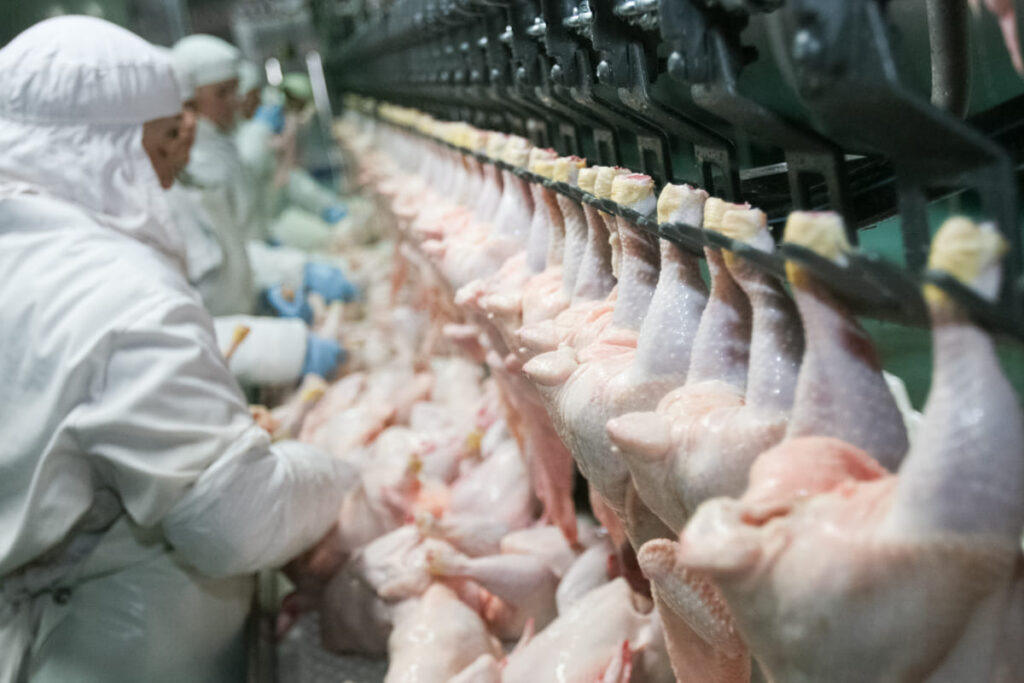Did you know that ice-chilling solutions can significantly extend the shelf life of poultry? In the food industry, making sure perishable items remain safe and fresh is essential.
In this blog post, we will explore how ice chilling solution extends the shelf life of poultry through innovative technologies such as Functional Ice (FICE) and its antimicrobial properties. We’ll delve into the key component in FICE formulation – sodium tripolyphosphate – and discuss its role in enhancing water retention capabilities and yielding quality outcomes across diverse applications.

As we continue our exploration, we will examine various sectors within food processing plants where these cutting-edge solutions are being applied to extend shelf life for chilled/frozen meats while improving overall food safety standards through reduced microbial growth.
Lastly, we’ll address the implications for stakeholders in the food industry including reduction in spoilage rates, maintaining product quality, increased profitability, meeting stringent international food safety standards, and building customer trust through improved shelf life and quality. So join us on this fascinating journey to better understand how ice-chilling solution extends the shelf life of poultry!
Functional Ice (FICE) and Its Antimicrobial Properties: A Chilling Revolution
Let’s dive right in.
Have you ever pondered how to prolong the freshness of poultry products without affecting their quality?
Well, say hello to Functional Ice (FICE), an innovative solution that not only chills your poultry but also fights bacteria.
It’s fascinating, isn’t it? Let me break it down for you:
The Development Process Behind Functional Ice Technology
In a nutshell, FICE is created by freezing food-grade ingredient solutions into ice form.
This unique method has shown promising results in extending the shelf life of raw poultry thigh meat during refrigerated storage.
A Cool Comparison Between FICE and Traditional Chilling Methods
You might be wondering what makes FICE so special compared to regular ice-chilling methods.
Studies have shown that FICE’s antimicrobial properties significantly decrease the population of Salmonella Typhimurium on inoculated thighs as opposed to traditional chilling techniques using regular ice.
Sodium Tripolyphosphate – A Key Component in FICE Formulation
Moving on, let’s talk about sodium tripolyphosphate – a game-changing component found in functional ice formulations.
How Sodium Tripolyphosphate Enhances Water Retention Capabilities
This phosphate compound works wonders at concentrations up to 5% within functional ice formulations.
Besides its well-documented antimicrobial properties, it also increases water retention in raw thigh meat.
Effects on Yield Quality Outcomes Across Diverse Applications
But wait, there’s more.
Sodium tripolyphosphate doesn’t just improve water retention – it also enhances the yield, quality, and shelf life of your poultry products.
Studies have shown that sodium tripolyphosphate-based functional ice can be a game-changer for food processing plants across various sectors.
So there you have it. A quick introduction to Functional Ice and its impressive antimicrobial properties. Stay tuned as we explore further applications of FICE within the food industry.
Functional Ice (FICE) is an innovative solution that extends the shelf life of raw poultry by freezing food-grade ingredient solutions into ice form. FICE’s antimicrobial properties significantly decrease the population of Salmonella Typhimurium on inoculated thighs as opposed to traditional chilling techniques using regular ice, making it a game-changer for food processing plants across various sectors.
Sodium Tripolyphosphate – A Key Component in FICE Formulation
Let’s plunge into the mysterious component.
Sodium tripolyphosphate (STPP) is a game-changer when it comes to functional ice and extending the shelf life of poultry products.
Why? Because of its antimicrobial properties.
But wait, there’s more.
How Sodium Tripolyphosphate Enhances Water Retention Capabilities
You see, STPP not only fights off bacteria but also increases water retention in meat products like raw thigh meat. This means less drip loss during storage and transportation – ultimately leading to better quality products on your plate.
Fancy some juicy chicken thighs?
Effects on Yield Quality Outcomes Across Diverse Applications
Beyond just poultry, STPP can be used across various food processing applications with equally impressive results. It can be used for fishery items, seafood distributors, and chilled/frozen meat importers/exporters. So how does this all work? Well, by incorporating up to 5% STPP in FICE, we’re able to improve yield, and quality, and extend shelf life. Talk about a triple threat.
Now that you’re in the know about sodium tripolyphosphate, let’s explore how functional ice technology can be applied across various sectors within food processing plants. Ready to revolutionize your poultry game? Let’s do this.
Applications Across Various Sectors Within Food Processing Plants
Alright, let’s dive into the cool world of functional ice (FICE) and its versatile applications.
Not only does FICE work wonders in chilling poultry products like fishery items or seafood distributed by importers/exporters worldwide, but it also has a wide range of uses within food processing plants.
Extending Shelf Life for Chilled/Frozen Meats with FICE Solutions:
You heard that right. By using FICE technology, you can extend the shelf life of various chilled and frozen meat products while improving their overall quality.
This is all thanks to sodium tripolyphosphate-based functional ice, which significantly reduces bacterial contamination levels during refrigerated storage. Science approves, folks.
- Pro Tip: This extended shelf life could lead to reduced waste and more efficient use of resources – a win-win situation for both businesses and consumers alike.
Improving Overall Food Safety Standards through Reduced Microbial Growth:
Safety first. With FICE technology in your arsenal, you’ll be able to reduce microbial growth on your meat products during refrigerated storage. This leads to improved food safety standards across the board.
- Note: Better food safety means happier customers who trust your brand for providing high-quality perishable items with extended shelf lives.
So, whether you’re a fishery business owner, seafood distributor, or chilled/frozen meat importer/exporter – it’s time to embrace the power of available ice technology.
Ready to Level Up Your Food Processing Game? Check out Hiceay for Top-Notch Ice Machines and Solutions.
In conclusion, FICE is not just about keeping things cool; it’s also about extending shelf life and ensuring food safety across various sectors within food processing plants. So go ahead and give this innovative solution a try today.
Functional ice (FICE) technology can extend the shelf life of chilled and frozen meat products, reducing bacterial contamination levels during refrigerated storage. FICE also improves food safety standards by reducing microbial growth on perishable items, leading to happier customers who trust your brand for providing high-quality products with extended shelf lives.
Implications for Stakeholders in the Food Industry
Let’s get into the specifics.
Adopting functional ice technology can lead to a reduction in spoilage rates while maintaining product quality throughout storage periods. This is great news for fishery businesses, seafood distributors, chilled and frozen meat importers, and exporters alike.
But wait, there’s more…
Reduction in Spoilage Rates and Maintaining Product Quality
Say goodbye to waste and hello to efficiency. By using functional ice solutions like sodium tripolyphosphate-based FICE, companies can significantly reduce bacterial contamination levels on their products during refrigerated storage. This means longer shelf life without compromising taste or texture – a win-win situation if you ask me.
Increased Profitability for Various Stakeholders
Show me the money.
- Fisheries: Less spoilage equals higher profits from fresher catches reaching consumers’ plates faster than ever before.
- Distributors: Longer-lasting products translate into fewer returns due to spoiled goods – which ultimately leads to increased revenue margins.
- Importers/Exporters: By providing extended shelf life through innovative chilling methods like FICE technology, these stakeholders stand out among competitors as they deliver high-quality perishable items worldwide.
Hiceay, the leading manufacturer of premium quality ice machines, is at the forefront of this revolution in food preservation. By incorporating functional ice technology into their products, they’re making it easier for businesses across various sectors to improve their bottom line. And that’s not all…

Enhancing Commitment Towards Providing Safe-to-Consume Goods
Safety first. Reducing microbial growth on poultry products during refrigerated storage using FICE solutions like sodium tripolyphosphate-based functional ice helps companies meet stringent international standards. This ultimately contributes to building trust among customers who demand high-quality perishable items with extended shelf lives.
Meeting Stringent International Food Safety Standards
- FICE technology enables companies to adhere to strict FDA regulations.
- Antimicrobial agents such as sodium tripolyphosphate ensure that bacterial contamination levels remain low throughout storage periods.
Building Customer Trust Through Improved Shelf Life and Quality
- In an era of heightened consumer awareness, guaranteeing the safety of food products is essential for sustaining customer faith and devotion.
- Functional Ice technology allows businesses within the food industry to deliver just that – ensuring a bright future for everyone involved.
Functional ice technology, such as sodium tripolyphosphate-based FICE, can reduce bacterial contamination levels on poultry products during refrigerated storage and extend their shelf life without compromising taste or texture.
This leads to increased profitability for stakeholders in the food industry, including fisheries, distributors, and importers/exporters while enhancing commitment towards providing safe-to-consume goods that meet stringent international food safety standards and building customer trust through improved quality.
Enhancing Commitment Towards Providing Safe-to-Consume Goods
Let’s dive into the nitty-gritty of how FICE solutions help companies step up their game in food safety. We’re talking about providing top-notch poultry products that not only taste great but also meet stringent international standards. Remember sodium tripolyphosphate-based functional ice? This magical ingredient does wonders for extending shelf life and reducing microbial growth on your favorite chicken dishes.
Meeting Stringent International Food Safety Standards
So, why is this important? Well, with ever-evolving global regulations and increasing consumer awareness, it’s essential to stay ahead of the curve regarding food safety practices.
FICE technology helps businesses comply with these strict guidelines by significantly decreasing bacterial contamination levels in chilled poultry products. No more worrying about salmonella outbreaks.
Bonus: It also improves water retention capabilities, and yields quality outcomes across diverse applications – a win-win situation for everyone involved.
Building Customer Trust Through Improved Shelf Life and Quality
Moving on to trust-building – an invaluable asset in today’s competitive market landscape. When customers know they can rely on your brand for safe-to-consume goods that boast extended shelf lives without compromising quality or taste, you’ve got yourself some loyal fans.
And guess what?
FICE solutions help you achieve just that. Studies have shown a significant reduction in microbial growth on poultry products during refrigerated storage when using sodium tripolyphosphate-based functional ice.
The use of sodium tripolyphosphate-based functional ice can result in a noticeable decrease in microbial growth on refrigerated poultry products, which could lead to increased consumer confidence and customer loyalty – two key factors that contribute to business success.
So go ahead, embrace FICE technology, and watch as it revolutionizes the way you handle perishable items while keeping customers happy and coming back for more.
FAQs in Relation to How Does Ice Chilling Solution Extend the Shelf Life of Poultry?
How Can You Extend the Shelf Life of Chicken?
To extend the shelf life of a chicken, use a combination of proper storage techniques and Functional Ice (FICE) chilling solutions. FICE contains antimicrobial properties and sodium tripolyphosphate to enhance water retention, reducing microbial growth and spoilage rates.
This results in improved product quality and extended freshness. Always store chilled or frozen meats at appropriate temperatures.
Why Is Ice Used to Maintain the Freshness of the Chicken?
Ice is used because it effectively maintains low temperatures that inhibit bacterial growth, preserving meat’s freshness for longer periods. Traditional ice methods have been enhanced by Functional Ice technology which provides additional benefits such as reduced microbial growth, increased yield quality outcomes, and improved overall food safety standards.
Why Is Chilling and Freezing Important in the Meat Industry?
Chilling and freezing are crucial processes in the meat industry as they help preserve perishable products by slowing down enzymatic activity responsible for spoilage while inhibiting bacterial growth.
These processes ensure that meats remain fresh during transportation, storage, and distribution, ultimately leading to better product quality for consumers while meeting international food safety standards.
What Is the Chilling Method in Poultry?
The chilling method involves rapidly cooling freshly slaughtered poultry carcasses using cold air or immersion into cold water mixed with ice or a functional ice solution like FICE. The process aims to reduce the internal temperature below 4°C (39°F), thus minimizing bacterial proliferation on carcass surfaces while maintaining optimal texture, flavor profile, and appearance throughout its intended shelf-life period.
Conclusion
Functional Ice (FICE) is a revolutionary technology that has the potential to extend the shelf life of perishable goods, including poultry. By leveraging antimicrobial properties and sodium tripolyphosphate-based formulations, FICE can improve water retention capabilities and yield quality outcomes.
This makes it an attractive option for various food processing sectors looking to enhance food safety standards while reducing spoilage rates.
Overall, FICE offers several benefits for stakeholders in the food industry, including increased profitability through efficient resource utilization and building trust among customers by meeting stringent international food safety standards.
By catering to consumer demands for longer-lasting, high-quality perishables, businesses can stay competitive in today’s market.
If you’re interested in learning more about how ice chilling solutions like FICE can benefit your business and help extend the shelf life of poultry or other perishable goods, contact Project Hiceay today!



